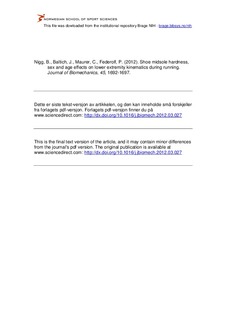| dc.contributor.author | Nigg, Benno | |
| dc.contributor.author | Baltich, Jennifer | |
| dc.contributor.author | Maurer, Christian | |
| dc.contributor.author | Federolf, Peter | |
| dc.date.accessioned | 2012-12-11T10:51:46Z | |
| dc.date.available | 2012-12-11T10:51:46Z | |
| dc.date.issued | 2012-06 | |
| dc.identifier | Seksjon for fysisk prestasjonsevne / Department of Physical Performance | |
| dc.identifier.citation | Journal of Biomechanics. 2012, 45(9), 1692-1697 | no_NO |
| dc.identifier.issn | 0021-9290 | |
| dc.identifier.uri | http://hdl.handle.net/11250/171074 | |
| dc.description | I Brage finner du siste tekst-versjon av artikkelen, og den kan inneholde ubetydelige forskjeller fra forlagets pdf-versjon. Forlagets pdf-versjon finner du på www.sciencedirect.com: http://dx.doi.org/10.1016/j.jbiomech.2012.03.027 / In Brage you'll find the final text version of the article, and it may contain insignificant differences from the journal's pdf version. The definitive version is available at www.sciencedirect.com: http://dx.doi.org/10.1016/j.jbiomech.2012.03.027 | no_NO |
| dc.description.abstract | Previous studies investigating the effects of shoe midsole hardness on running kinematics have often used male subjects from within a narrow age range. It is unknown whether shoe midsole hardness has the same kinematic effect on male and female runners as well as runners from different age categories. As sex and age have an effect on running kinematics, it is important to understand if shoe midsole hardness affects the kinematics of these groups in a similar fashion. However, current literature on the effects of sex and age on running kinematics are also limited to a narrow age range distribution in their study population. Therefore, this study tested the influence of three different midsole hardness conditions, sex and age on the lower extremity kinematics during heel-toe running. A comprehensive analysis approach was used to analyze the lower-extremity kinematic gait variables for 93 runners (male and female) aged 16–75 years. Participants ran at 3.33±0.15 m/s on a 30 m-long runway with soft, medium and hard midsoles. A principal component analysis combined with a support vector machine showed that running kinematics based on shoe midsole hardness, sex, and age were separable and classifiable. Shoe midsole hardness demonstrated a subject-independent effect on the kinematics of running. Additionally, it was found that age differences affected the more dominant movement components of running compared to differences due to the sex of a runner. | no_NO |
| dc.language.iso | eng | no_NO |
| dc.publisher | Elsevier | no_NO |
| dc.subject | heel-toe runners | no_NO |
| dc.subject | shoe cushioning | no_NO |
| dc.subject | movement analysis | no_NO |
| dc.subject | principal component analysis | no_NO |
| dc.title | Shoe midsole hardness, sex and age effects on lower extremity kinematics during running | no_NO |
| dc.type | Journal article | no_NO |
| dc.type | Peer reviewed | no_NO |
| dc.subject.nsi | VDP::Technology: 500 | no_NO |
| dc.source.pagenumber | 1692-1697 | no_NO |
| dc.source.volume | 45 | no_NO |
| dc.source.journal | Journal of Biomechanics | no_NO |
| dc.source.issue | 9 | no_NO |
